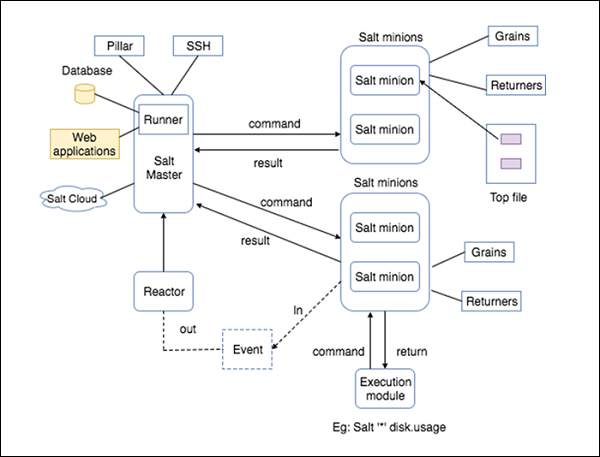
- SaltStack Tutorial
- SaltStack - Home
- SaltStack - Overview
- SaltStack - Architecture
- SaltStack - Competitors
- SaltStack - Installation
- Creating a Simple Environment
- SaltStack - Access Control System
- SaltStack - Job Management
- SaltStack - Salt File Server
- SaltStack - Git as a File Server
- Using MinionFS as the File Server
- SaltStack - Using Cron with Salt
- SaltStack - Remote Execution
- Configuration Management
- SaltStack - Logging
- SaltStack - Salt through SSH
- Salt for Cloud Infrastructure
- SaltStack - Salt Proxy Minions
- SaltStack - Event system
- SaltStack - Orchestration
- SaltStack - Salt Package Manager
- SaltStack - Python API
- SaltStack - Working Example
- SaltStack Useful Resources
- SaltStack - Quick Guide
- SaltStack - Useful Resources
- SaltStack - Discussion
SaltStack - Architecture
The architecture of SaltStack is designed to work with any number of servers, from local network systems to other deployments across different data centers. Architecture is a simple server/client model with the needed functionality built into a single set of daemons.
Take a look at the following illustration. It shows the different components of SaltStack architecture.

SaltMaster − SaltMaster is the master daemon. A SaltMaster is used to send commands and configurations to the Salt slaves. A single master can manage multiple masters.
SaltMinions − SaltMinion is the slave daemon. A Salt minion receives commands and configuration from the SaltMaster.
Execution − Modules and Adhoc commands executed from the command line against one or more minions. It performs Real-time Monitoring.
Formulas − Formulas are pre-written Salt States. They are as open-ended as Salt States themselves and can be used for tasks such as installing a package, configuring and starting a service, setting up users or permissions and many other common tasks.
Grains − Grains is an interface that provides information specific to a minion. The information available through the grains interface is static. Grains get loaded when the Salt minion starts. This means that the information in grains is unchanging. Therefore, grains information could be about the running kernel or the operating system. It is case insensitive.
Pillar − A pillar is an interface that generates and stores highly sensitive data specific to a particular minion, such as cryptographic keys and passwords. It stores data in a key/value pair and the data is managed in a similar way as the Salt State Tree.
Top File − Matches Salt states and pillar data to Salt minions.
Runners − It is a module located inside the SaltMaster and performs tasks such as job status, connection status, read data from external APIs, query connected salt minions and more.
Returners − Returns data from Salt minions to another system.
Reactor − It is responsible for triggering reactions when events occur in your SaltStack environment.
SaltCloud − Salt Cloud provides a powerful interface to interact with cloud hosts.
SaltSSH − Run Salt commands over SSH on systems without using Salt minion.
In the next chapter, we will learn in detail about the various competitors of SaltStack and their features.